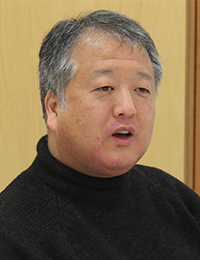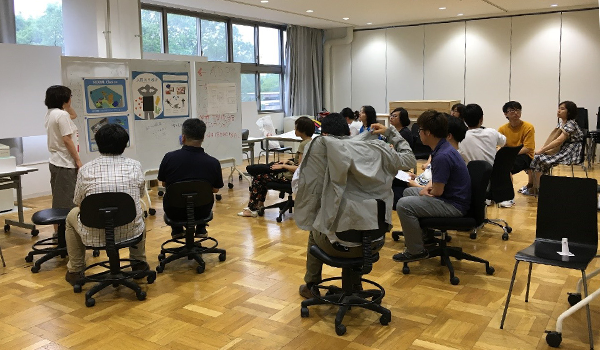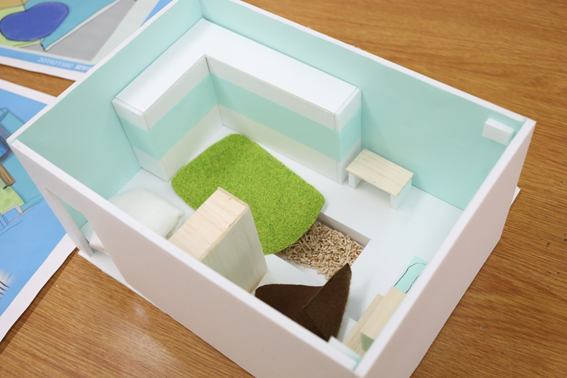キーワード:感覚ダイバーシティ、感覚過敏、デザイン、心理学、神経科学
https://www.geijutsu.tsukuba.ac.jp/kabin-design/
 私たちの公共空間は、多くの人にとって心地よい環境に設計されています。しかし、音や光の感じ方は人によって異なり、中には同じ空間にいるのも耐えられないほどに苦痛を感じる人もいます。
私たちの公共空間は、多くの人にとって心地よい環境に設計されています。しかし、音や光の感じ方は人によって異なり、中には同じ空間にいるのも耐えられないほどに苦痛を感じる人もいます。
感覚の違う人同士が同じ空間で心地よく過ごすための方法を模索するため、脳科学、心理、デザイン、建築、構成、障がい者支援の専門家が連携して研究を進めているのが、感覚ダイバーシティデザイン・リサーチユニットです。
異なる感覚を持った人同士が集まれば、新しい世界を知るきっかけにも繋がる
当リサーチユニットでは、人それぞれ異なる感覚の多様性に着目し、どんな感覚を持った人も共存できる環境づくりを目指しています。
特定の人が抱く不快な感覚に関してはリハビリや分離などの方法がとられてきましたが、適切な空間で過ごすことができれば、苦痛を伴うリハビリを経ずとも支障のない日常生活を送れることもあります。また、異なる感覚を持つ人が同じ空間に居合わせることによって、それぞれが新しい世界を知るきっかけにも繋がります。

図1:まぶしさの感じ方の違いを表す図。どちらも同じ明るさだが、輪郭のはっきりした縞模様が一番まぶしく見えることが多い。
感覚が敏感だといっても、許容できる範囲が「狭い」というだけで「ない」わけではありませんので、一定の条件下で一緒に過ごすことは可能です。感覚に関する苦痛をデザインの力で軽減するだけでなく、お互いが今まで以上に力を発揮できる環境をつくることも当プロジェクトの重要な目的のひとつです。
脳活動の分析から望ましい環境づくりまでをワンストップで取り組む

図2:DACセンター・佐々木銀河先生と建築デザイン・山田協太先生との共同授業の様子
脳の仕組みについて分析する脳科学・心理領域と、解決方法を模索するための環境デザイン・支援領域で連携して研究を進めています。脳科学・心理領域では、fNIRS(近赤外線脳計測装置)、fMRI(機能的磁気共鳴イメージング装置)を使用し、人が苦手なものを見た時に反応する脳活動を分析し、そのデータをもとにどのような環境整備を行うのが良いか検討します。デザイン・支援領域では、当事者の方に問題点をヒアリングし、試作品についてフィードバックをもらうサイクルで最適解を導いていきます。

図3:休憩室のデザインについて考える授業で学生が制作した作品
最近では、リサーチユニットメンバーのDACセンター・佐々木銀河先生が中心となって、感覚が過敏な人のための休憩スペースを学内に設けました。その休憩スペースのデザインを、私の学生と建築デザイン・山田協太先生の学生で考えるというプロジェクトを大学院の授業の一環として進めています。スペース内は光を抑え、リラックス効果のあるアロマやバブルチューブなどを置くとよいのではないかと考えています。知覚過敏の人は感覚刺激を好む傾向があり、実験的に様々な触感のあるアイテムを置いてユーザーへの検証を行い、より良い環境づくりと研究に役立てていきたいと考えています。感覚過敏や対処法の実践に関しては、職場や学校で理解が得られない場合も多いのが現状です。積極的にシンポジウムや学会で研究成果を発信し、感覚の多様性が理解され、すべての人に配慮される社会の実現に向けて努めていきます。
社会への貢献・実績
- 感覚が過敏な人のための休憩スペースを学内に設置(2020年)
- 発達障害シンポジウム2018 個性的な感覚世界の謎.敏感さ、鈍感さってなあに? 個性的な感覚と共に生きる社会 (ライト・イット・アップ・ブルー所沢共催)(2018年4月1日,西武所沢ワルツホール)
- 発達障害シンポジウム2019 敏感な感覚にも心地よい環境って?(ライト・イット・アップ・ブルー所沢共催)(2019年4月20日,所沢市こどもと福祉の未来館)
- 公開講演会:“ここちよい” ”つらい” 感覚の科学 ~多様な感覚をもつ人同士の共生社会に向けて~ 日本学術振興会「課題設定による先導的人文学・社会科学研究推進事業 領域開拓プログラム」公開講演会(2018年12月26日,筑波大学東京キャンパス)
取材日:2020年2月6日
Creating Comfortable Environments for People with Different Senses to Live Together
Unit members : Sasaki, Ginga Yamada, Kyota
Other agencies : Ide, Masakazu Midorikawa, Akira Shigemune, Yayoi Ohshima, Remi Atsumi, Takeshi
Unit name: Sensory Diversity Design Research Unit
Key words: sensory diversity, sensory hypersensitivity, design, psychology neuroscience
https://www.geijutsu.tsukuba.ac.jp/kabin-design/

Our public spaces are designed to be comfortable for most people. However, the perception of sound and light varies among individuals, and the same space may be unbearably distressing to some people.
The Sensory Diversity Design Research Unit conducts research through collaboration among specialists of brain science, psychology, architecture, art and design science, and disability science to explore methods for people with different senses to live together feeling comfortable.
Living with people with different senses can acquire new experiences
Focusing on sensory diversity or differences in senses among individuals, we aim to create environments for all people to stay together despite sensory diversity.
People with sensory hypersensitivity has been supported from rehabilitation approach such as habituation exercise , or separation by sensory differences. However, by creating appropriate spaces for these people, it may be possible for all of us to live together with comfort. People with different senses can also acquire new experiences by sharing spaces with others.

Figure 1: An example to compare the glare sensation. The brightness is the same between the left and right stripe patterns, but the pattern with a clear outline is more glaring.
In the case of people with hypersensitivity, their tolerance is “limited”, but this does not mean that they have “no tolerance”. Sometimes they show strong preference for certain kinds of stimulus. So they can share spaces with others under certain conditions. One of our important goals is to not only reduce sensory distress using elaborate designs, but also create environments for each person to display his/her further potential.
Adopting one-stop approach: from analyzing brain activity to creating desirable environments

Figure 2: A view of a collaborative class session held by Professors Sasaki Ginga (DAC Center) and Yamada Kyota (architecture designs)
We conduct research, integrating brain science/psychology to analyze brain mechanisms and environmental designs/support to develop methods for problem-solving. In the areas of brain science/psychology, we use the near-infrared brain imaging system (fNIRS) and functional magnetic resonance imaging (fMRI) to analyze the brain activity when people see something they like/dislike, and collect data to discuss measures for environmental improvement. In the areas of designs/support, we interview people with difficulties, and obtain feedback on our prototypes from them to find optimal solutions as a cycle.

Figure 3: A model created by students participating in a program to design a rest area
We have recently created a rest area for people with hypersensitivity on campus under the leadership of Professor Sasaki Ginga of the DAC Center, who also belongs to our unit. As part of a graduate course, my students and those of Professor Yamada Kyota in charge of architectural designs are participating in a project to design this space. We are considering reducing the brightness of lighting devices, and filling the space with natural scents and bubble tubes for relaxation. As people with hypersensitivity tend to prefer sensory stimulation, we will experimentally distribute various items that produce different tactile sensations, and collect opinions about them from users to create better improvements. As a matter of fact, it is not easy to obtain understanding of hypersensitivity and its management in workplaces and schools. To realize a society with a sufficient understanding of sensory diversity and considerations for all people, we will actively report our research results at symposiums and academic meetings.
Social contributions and achievements
- Creating a rest area on campus for people with hypersensitivity (2020)
- Organizing the Developmental Disability Symposium 2018 – Sensory Diversity: From Hypersensitivity to Hyposensitivity – To Realize a Society for People with Different Senses (co-sponsored by Light-It-Up-Blue Tokorozawa at Seibu Tokorozawa Walz Hall on April 1, 2018)
- Organizing the Developmental Disability Symposium 2019 – Creating Comfortable Environments for People With and Without Hypersensitivity (co-sponsored by Light-It-Up-Blue Tokorozawa at Tokorozawa City Hall for the Future of Children and Welfare on April 20, 2019)
- Giving an open lecture entitled: The Science of Senses Such as “Comfort” and “Distress” – Toward the Realization of a Society for People with Diverse Senses to Live Together Feeling Comfortable – as part of the <Topic-setting Program to Advance Cutting-edge Humanities and Social Science Research to Address> led by the Japan Society for the Promotion of Science (Tokyo Campus, the University of Tsukuba on December 26, 2018)
Interviewed on February 6, 2020
